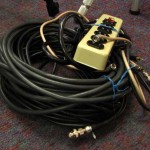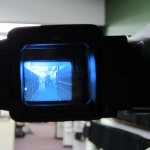BSV 1172, Chapter 1: What’s a tube / Why a tube / Really? A tube camera?
Earlier this summer I had planned to make a short film about a percussionist – basically capturing a handful of performances in HD – but for various reasons the project was put on hold [read: not abandoned, not aborted; merely on hold] and while poking around the internet – more specifically, YouTube, that grand time-waster extraordinaire – I found some videos people has posted showing off some really old video cameras.
The first video consisted of a plugged in 1986 Panasonic camcorder, and the second video was a clever evocation of an eighties video using an old camcorder to film a corner desk filled with gear of the era – a kind of time capsule, filmed in the present day. The third video consists of night shots where the lights comet-tailed / streaked across the screen, and the common denominator that linked all three videos was the use of a camcorder using a tube rather than CCD chip to record images.
Years ago I owned a Sony DXC-1820, a tube camera, but never really used it for anything because it required a huge amount of light to create clean pictures, and the camera was massive – far heavier than the Sony V-801 Hi8 CCD camcorder I used for taping archival dance performances at fFIDA. This was around 1994-1995. Besides the unique ‘tube look’ the camera was from a pre-camcorder era, which means there was no recorder built into the camera.

The first portable camera-recorder setups two two-parters: a camera with a fat cable connected to a separate VCR. This was the beginning of early non-film electronic news gathering (ENG), and Sony’s first effort debuted in 1967 via the Sony Video Rover, also dubbed the portapak system. The cameras filmed black & white images (and later colour), and the VCRs were reel-to-reel – which sounds like madness, but isn’t: if videotape was the natural offshoot of audiotape, it makes sense the former’s consumer / prosumer debut would use the familiar threading and tape engaging system of reel to reel audiotape.
For a good 15+ years, this two-part system remained in use both professionally (ENG) and within the prosumer market (industrial videos, educational & corporate use) until the mid-eighties. In 1983, Sony carried over their camcorder design from their 1982 ENG Betacam units to the consumer Betamax format. Once Beta and VHS switched from camera + recorder to camcorder, the two-part system became obsolete.
In between the switch was the introduction of consumer-grade CCD cameras: because they began to emerge in 1981 (via Hitachi, and soon other manufacturers), they too were two-parters, requiring a fat cable that connected the camera to a separate VCR.
The cables generally did three things: they powered the cameras, they send the sound & images to be record to the VCR, and they could also play back the taped footage via the camera’s viewfinder. You could also buy separate standalone power units which had video and audio out plugs which could be connected to a monitor / TV or VCR – another carry-down from the camera + separate power packs of the seventies.
The two-part system was cumbersome, heavy, and to present day consumers, ridiculous in that everything you needed was not contained in one light, easy to carry unit from which you can pop out a tape, hard drive, memory stick / card.
On the other hand, because the two-parters were carry-overs from the professional and prosumer realms, the cameras were solid-built [read: metal chassis and in some cases, outer shell], and often contained great lenses which could also be adapted for additional telephoto & wide angle scope through the use of adapter lenses. These lenses extenders weren’t exclusive to the pre-camcorder units, but they were smartly interchangeable.

Several of RCA’s tube and early CCD cameras used the same wide and tele lenses, as did Sony’s prosumer HVC series (the snazzy cameras that preceded the Betamax camcorder). Canon also made their set of lens extenders that could be used on video cameras as well as Super8 cameras.
Another plus: most of the cameras were made by just a handful of companies in Japan. Many of the lenses – including those for RCA – were made in Japan when the country was well established as the pinnacle of quality manufacturing. The Japanese-made gear also permitted a peculiar level of interchangeability: Panasonic made the cameras for Quasar, Olympus, Canon, and General Electric, so if you pick up a VCR, a camera, a detachable viewfinder, and a power supply unit by any one of these companies, depending on the manufacturing style, many of these re-badged components will work together.
This is kind of foils the propriety designs of some present day gear which makes it impossible to mix & match components, let alone know whether or not your camera will become obsolete in less than a year. Case in point again: the fact RCA’s lenses and film slide transfer attachments could be used among tube & CCD cameras spanning several years.
Another odd bonus: although consumer cameras didn’t offer detachable lenses like their prosumer counterparts, you can mix & match some lenses with occasional success. It’s a lot like DSLR’s where there will be flaws – vignetting, limited focus in extreme ranges – but not whole incompatibilities. For the short film I was able to use RCA’s wide angle extender because it too fitted a 58mm thread; there was vignetting at its widest setting and focus became soft & hazy at the zoom setting, but unlike Canon’s fixed wide angle extender, I could zoom within a safe range and still get a clean picture. (The hazing of the image might also be handy for creating deliberately desired aberrant images.)
Again, none of this is unique to DSLR’s; there are many blogs that show camera collectors trying out vintage lenses from film, video, and stills. What I find fascinating is that these older cameras seem to offer a broader range than standard consumer gear of the 90s (assuming you’re after vintage gear).
So why did I opt for tube rather than CCD?
It’s a unique look where the colours are more pastel, the limited LUX rating adds a different kind of video grain, and the noise, which can be warped to create some really nice textures – nice being a subjective thing.
Consumer video gear is noisier than prosumer models, and that’s not a bad thing per se. Like film stock or cameras or video formats, you pick what suits the project or the aesthetics you’re after, and my desire was to get pastel colours which I could desaturate or ludiocrously saturate and get results distinct from HD.
There’s also the aesthics of filming a video store and its contents, atmosphere, and small daily nuances using technology that’s as outmoded as the concept of renting physical media in a downloadable, streaming age.
Now this is where the prior blog on video stores comes in. Renting & selling physical media in a traditional bricks & mortar establishment is outmoded. I won’t use obsolete because there’s nothing obsolete in getting goods & services from a physical place staffed by humans. You still need to get your hair cut, you have to buy frozen food from outside your home, get your car fixed, and for most people, you need some human interaction – particularly when there’s a problem (like, er, plumbing). Video renting could be seen as obsolete, but I prefer niche, and I think within the linked Editor’s Blog above, I make a few valid points on why physical media can’t die in the immediate future.
Back to the gear.
There are dual sides to working with tube cameras: the technical makeup and resulting visuals are unique, but they are prone to one specific horror that can ruin any future usage: burn spots.
Tubes are sensitive to extreme light, and you can’t point them at sharp hot spots without risking some permanent black spot or burn-in halo. It can happen, and that’s the additional risk in buying tube gear (of which my own exploits via ebay will be discussed in another blog).
It’s like a dead pixel, except unlike a Canon DSLR, there’s no reset switch that redraws the pixel grid to erase aberrations. The spot is there, and every time you pan or tilt, zoom or pull back, that goddamn spot or streak is there. Worse, there’s the issue of getting replacement tubes for what’s essentially an antique. Tubes burn easily, and they die slowly, with colours warping sometimes to an unwavering green shade. (More on that in another blog, too.)
Tubes have been around for decades, and were in the first studio cameras that brought images to early TV households in the late forties. The types you commonly find within the late 70s / early 80s gear are Vidicons (early 70s Sony cameras), Saticons (Hitachi cameras, as well as other brands), Newvicons (various brands), and Trinicons (Sony).
And like the current pro 3-chip cameras, you had 2-tube (one each for luminance & chrominace) and 3-tube cameras (each for red, green & blue colours) that were employed in pro and prosumer cameras. Consumer grade cameras stayed at the single tube variety with qualitative differences between each brand. Vidicons are more sensitive to bright lights (manuals & guides warn about chrome reflections) hence bigger risk of burns. Newvicons were developed to handle low light situations but the pictures, with some cameras, are prone to more comet-tailing and ghosting. To some experts, Saticons offered the best choice, and you also find them in so-called Hi-Band prosumer cameras which handle low light well, and offer robust, natural colours.
Sony’s Trinicons were found in both consumer, prosumer, and pro cameras, and reportedly had their own unique low light capabilities, although like any camera, low light = more noise, so while Ability might be there, the Capability to offer a clean sharp picture ain’t when compared to later CCD cameras. However, even the mid-90s Hi8 cameras produced images where you can see the digital compression, so there’s a plus to older tube cameras; the trade-off may be burn risk and intolerance to low light, but the images are free from compression artifacts.
In researching & scoping cameras for sale, I found and settled on two units for the short film: a 1985 Canon VC-50 Pro, and Sharp QC-54.

The Canon sports a Panasonic body, but uses a Canon lens whose 58mm thread accepts the aforementioned wide and tele lens extenders (which themselves also work on Panasonic / etc. models). Instead of the Newvicon tubes used by Panasonic, the Canons came with Saticon tubes, and the VC-50 uses a Hi-Band 6MHz tube instead of the Hi-Band 5MHz versions in models VC-10 thru -30.

The Sharp camera is almost identical (see the pattern of manufacturing and re-badging again?) to the Konica CV-301 camera. Both have really unique designs and were billed as the world’s smallest video camera around 1984. The tube resides in the pistol grip, and a mirror bounces images from the lens to the perpendicular tube.

The lens range is poor and there’s no electronic viewfinder, so you can’t replay video like the Canon or other conventional video cameras.
It’s a very bare bones camera that also produces smearish images in low light situations, and it has a limited focal depth… and yet this thing has an aesthetic wholly different from Canon’s lovely technical design.
Those are the cameras. In the next blog I’ll have a teaser trailer that offers a few quick shots from the film, and in subsequent installments we’ll talk about the method of recording the images, the cables, and some unique gear out there that helps fix cameras whose colour phasing is off, or simply can’t handle fluorescent lighting without making things green-yellow, and damn ugly.
Unless that’s what you’re after…
Mark R. Hasan, Editor
Big Head Amusements
